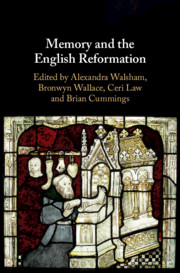Book contents
Introduction
Memory and the English Reformation
Published online by Cambridge University Press: 30 October 2020
Summary
The first part of the introduction explores how historians and literary scholars have approached early modern memory and sketches the trajectory of recent work on the memory of the English and European Reformations. It then examines the ways in which the religious revolution transformed the memorial culture it inherited from the medieval past and the manner in which it engendered new strategies of remembering and forgetting, commemoration and amnesia. The second section explains the architecture and structure of the volume, which is divided into four parts (1) Events and Temporalities; (2) Objects and Places (3) Lives and Afterlives; (4) Bodies and Rituals. It probes the temporal; spatial and material; biographical; and ceremonial and corporeal dimensions of the memory of the English Reformation, establishing a series of conceptual frameworks for the essays that follow. The Reformation is reconceptualised less as a unitary moment of rupture than as ongoing struggle to reconfigure the nation’s ecclesiastical and cultural heritage and to accommodate the unruly legacy of the past. A prolonged development involving impulses towards both historical preservation and oblivion, it continues to be refought in memory and the imagination.
- Type
- Chapter
- Information
- Memory and the English Reformation , pp. 1 - 46Publisher: Cambridge University PressPrint publication year: 2020



